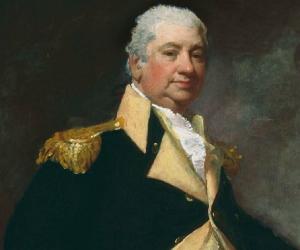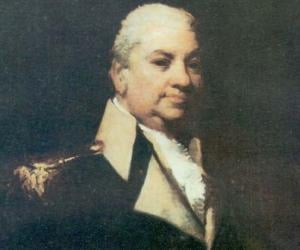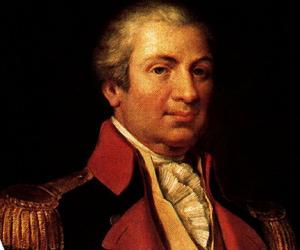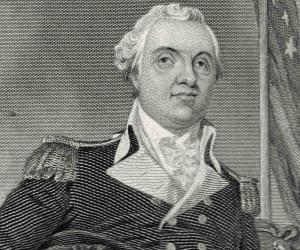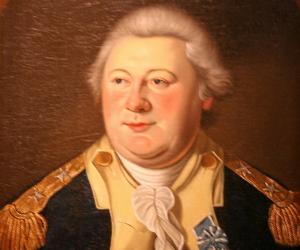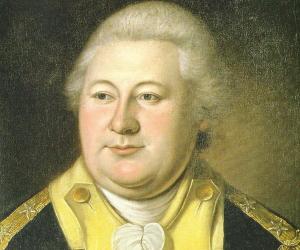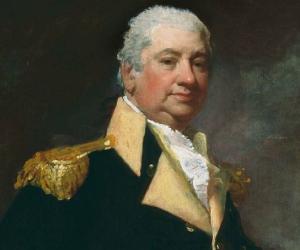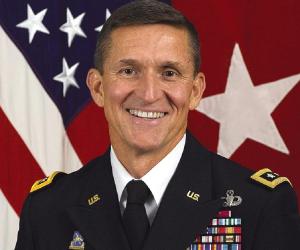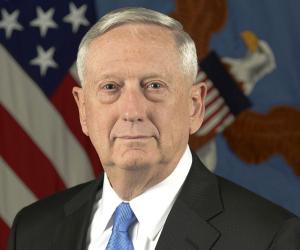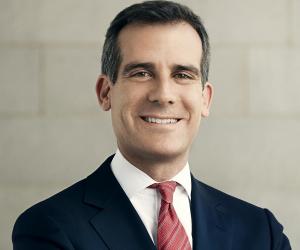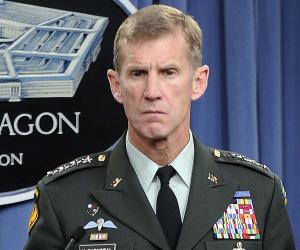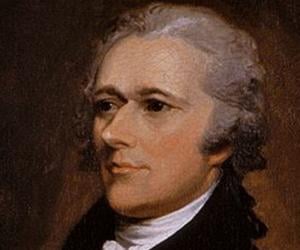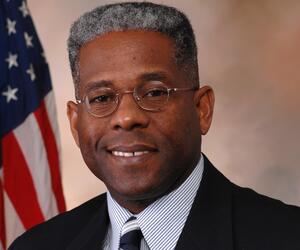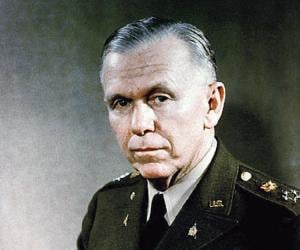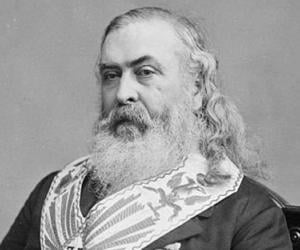Childhood & Early Life
Henry Knox was born on July 25, 1750, in Boston, Massachusetts, U.S., to Scotch–Irish couple William and Mary. William was a ship builder.
Knox attended the 'Boston Latin School,' where he studied Greek, Latin, arithmetic, and European history. He dropped out of school at the age of 9.
Being the eldest son in the family, he took over as the sole support to fix the family’s weak financial condition after his father died in the West Indies in 1762.
Knox landed a clerical job in a Boston bookstore owned by Nicholas Bowes. Bowes eventually became a father figure to him. He also supported Knox's interest in reading.
Over time, Knox worked hard to save enough money to open the 'London Book Store' in Boston in 1771.
He eventually became one of the toughest fighters in Boston's street gangs.
After being inspired by a military demonstration, at the age of 18, Knox joined a local artillery company called 'The Train.'
He was also active in Boston’s political scene and supported American colonial rights. He was associated with the secret revolutionary organization 'Sons of Liberty.'
Knox was involved in the Boston Massacre on March 5, 1770, as he tried to calm the situation by convincing the British CPT Joseph Pierce and his soldiers to return. Knox also testified at the trials of the soldiers.
Continue Reading Below
Military Career
In 1772, Knox joined the militia unit he co-founded, called the 'Boston Grenadier Corps' (a branch of 'The Train'). Soon, his remarkable leadership qualities resulted in his promotion to the rank of first lieutenant.
Despite being an expert in weaponry, Knox shot two of his fingers by accidentally discharging a gun in 1773. The wound was treated and eventually healed.
Soon after the battles of Lexington and Concord, the Siege of Boston (April 19, 1775–March 17, 1776) broke out. The siege was a prelude to the American Revolutionary War. Knox escaped Boston and joined a colonial militia unit.
His abandoned bookshop was burgled, and the remaining stock was destroyed.
He was the commander of rebel cannon fire during the Battle of Bunker Hill in June 1775. The following month, General George Washington arrived as the commander of the 'Continental Army' and was highly impressed by Knox.
In June 1775, he was drafted as the colonel and artillery in-charge of the newly formed 'Continental Army' in Cambridge, Massachusetts, by the 'Second Continental Congress.'
In November, Washington sanctioned Knox's plan to bring the captured British artillery pieces back to Boston from Fort Ticonderoga, New York. Knox successfully executed the plan by mid-January 1776.
The retrieved artillery was hence used by the colonial forces to end the British control over Boston.
The colonial forces compelled the British military base to evacuate Boston by March.
Continue Reading Below
In December 1776, with Washington's 'Continental Army,' Knox participated in the New York and New Jersey campaign to acquire control over the Port of New York and New Jersey.
He played a key role in crossing the Delaware River during the small yet significant Battle of Trenton (December 26, 1776). Soon after, he was promoted to the rank of brigadier general.
He also participated in the Battle of the Assunpink Creek on January 2, 1777, and the Battle of Princeton the following day.
In 1777, Knox moved back to Boston to improve the 'Continental Army's artillery-manufacturing capability. He subsequently gathered a supplementary battalion of artillery men and established an armory at Springfield, Massachusetts.
He then moved back to the main army and continued serving for the rest of the war.
He participated in the first major battle of the Philadelphia campaign at Brandywine. He was also at Germantown, where he had suggested (to Washington) the capture of the British-occupied home of Germantown resident Benjamin Chew, a move he later regretted.
The delay in his army’s advancement helped the British in re-establishing their lines. Thus, the Americans were defeated.
At the Battle of Monmouth in July 1778, he was distinguished as the artillery commander.
In 1780, Knox was a member of the panel that court-martialed British officer Major John André, who was acquitted of the charges of conspiring with American military leader Benedict Arnold to gain control over West Point.
Continue Reading Below
Knox placed his artillery, along with the French artillery and navy, in Washington to crush the British force. He eventually forced their surrender during the victorious Siege of Yorktown (1781). Following this, he was promoted to the rank of major general on March 22, 1782, becoming the youngest in the army to hold the rank.
In that capacity, he, along with Congressman Gouverneur Morris, made a failed attempt to negotiate prisoner exchanges with the British.
He moved to Newburgh, New York, to join the main army and inspect the West Point facilities, which he regarded as a vital defensive position, especially after the role it had played in the siege.
Washington appointed Knox as the West Point commander in August 1782.
Unfortunately, he lost his 9-month-old son the following month. Despite his grief, he continued his service and played a key role in negotiating the issue of military pensions and overdue compensations with the 'Confederation Congress' and Secretary of War Benjamin Lincoln.
With the onset of the preliminary peace in April 1783, the 'Congress' began to demobilize the army. Knox and Washington commanded the remaining officers.
Around the same time, in May 1783, Knox established the hereditary fraternity named the 'Society of the Cincinnati' for Revolutionary War officers. He served as the first secretary of the organization.
In December that year, he succeeded Washington as the commander-in-chief of the army. Lincoln resigned in November 1783 and recommended Knox as his successor. Previously, his name was recommended when Lincoln had been appointed for the post.
In 1784, Knox quit his army commission and returned to Massachusetts, where he served in a state commission that negotiated treaty provisions with the Penobscot Indians of central Maine.
Continue Reading Below
He finally became the secretary at war for the United States in March 1785, under the 'Articles of Confederation.' The title of the position was changed only after the 'War Department' was established on August 7, 1789, under the cabinet of the nation's first president, George Washington.
As the secretary at war, he supervised the army that had reduced to a fraction of its former size. With great difficulty, he managed to draft a small peacetime standing army. The 'Confederation Congress' opposed the establishment of the peacetime force and also Knox’s plans of setting up a naval academy and an army academy at West Point. The provisions were, however, eventually implemented.
He was also responsible for implementing the 'Militia Act of 1792.'
Knox resigned from the cabinet on January 2, 1795, and moved to his home in Thomaston, District of Maine. He was succeeded by Timothy Pickering.
Family, Personal Life & Death
Knox married Lucy Flucker, the daughter of the royal secretary of the Province of Massachusetts, in June 1774, much against her father's wishes. Since both of them were staunch patriots, they had to flee from Boston during the siege.
Knox later retired to his estate in Thomaston, Massachusetts (now Maine), called ‘Montpelier,’ with his wife. He lived there as an active and respected member of his community. He helped the community by generating employment, raising funds for the construction of a church, and establishing a local militia.
The two had 13 children, of which only one son, Henry Jackson Knox, survived to adulthood. Henry grew up to be a squanderer and a drunkard.
On October 25, 1806, Knox died at his home due to an infection he had suffered after choking on a chicken bone 3 days earlier. He had an honorary burial ceremony at his estate.
In 1871, ‘Montpelier’ was demolished to make way for the Brunswick-Rockland railroad line.
